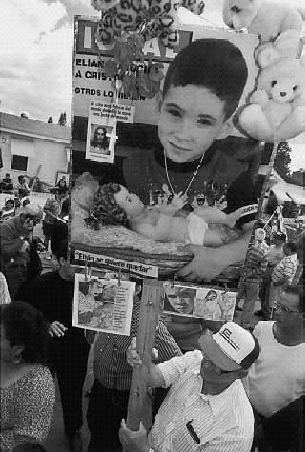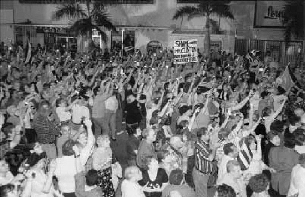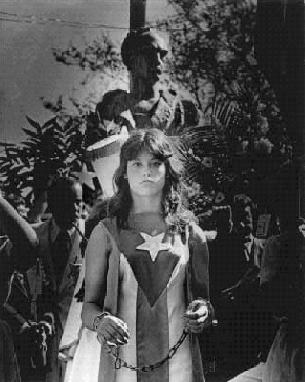The Unfolding Saga
What actually occurred in the Straits of Florida before Elián's rescue at sea remains a mystery. According to the official reports, a seventeen-foot aluminum boat left Cardenas, Cuba, for the United States on November 21, 1999, at 4:30 a.m. Stories that Elián's mother was seeking freedom for her child notwithstanding, it appears she probably left Cuba to follow her boyfriend, who had planned the boat trip. On board were fourteen individuals, one of them Elián. Hours before the boy was rescued, the boat capsized off the Florida Keys. Except for Elián and two adults, all the others drowned, including his mother, Elizabeth Brotons. Two Broward County fishermen, cousins, were out on the water when they spotted an inner tube bobbing in the ocean, shortly after 9 a.m. Thanksgiving morning. When he saw a hand move from within the tube, one of the fishermen jumped into the ocean and pulled Elián out of the water. Exhausted by his ordeal, Elián was taken to the hospital for medical treatment. He was released the following day, and the Immigration and Naturalization Service (INS) gave temporary custody of the boy to Lazaro González, the child's great-uncle, who lives in Miami. This ensured that the boy would be cared for while the agency determined his immigration status. The next day, November 27, from his home in Cardenas, the boy's father, Juan Miguel González, demanded the return of his son. With that, Elián was thrust to the epicenter of a fierce political tug-of-war between the Exilic and Resident Cuban communities.
Four days after Elián was pulled from the water, on November 29, he literally became the poster child for the Exilic community. Because it was believed that Fidel Castro might attend the World Trade Organization meeting that early December in Seattle, posters and flyers were rapidly produced with a picture of Elián on a stretcher under the caption "Another Child Victim of Fidel Castro." Elián's political appeal as a symbol of opposition to the Castro regime was obvious. Yet his true value to the community became apparent only with his transformation into a religious symbol. This rapid metamorphosis was not the Machiavellian formulation of a few individuals with political power, but rather the cumulative effort of the entire Exilic Cuban community in its attempt to comprehend the will of a God who had seemed so silent during the forty years of their "captivity" in Miami.
As a sacred symbol, Elián merged the religious and political hopes of the Miami Cuban community. According to Father Francisco Santana of Our Lady of Charity Shrine, "[Exilic Cubans] were making the connection
Elián's physicians insisted that the child failed to demonstrate any physical evidence of prolonged exposure to the sea, concluding that the boy was in the water for hours, not days. Nevertheless, as the story spread, his few hours in the ocean became two and a half days, in turn raising the question, How can a child survive that long, alone, in the sea? The answer, clearly, was, Only by a miracle from God. As the battle over Elián's immigration status grew fierce, his symbolic worth increased as the Exilic community spoke of him in deeply religious terms. An unconfirmed report, circulated widely within the community, recounted the tale of dolphins circling Elián's inner tube, protecting him from sharks. Dolphins, in the early Christian Church, symbolized salvation: not only was Elián saved, but now he had come to save. Even the Midrash (Jewish rabbinical commentaries) contains stories of how dolphins saved some Israelite children who lagged behind while crossing the parted Red Sea during their flight from Egyptian bondage.
"He's a miracle," said Maria Rodriguez, fifty-five, while attending the annual Three Kings Day Parade, a celebration of the three wise men bringing gifts to the baby Jesus. "The fact that he made it for two days, with dolphins circling around him—that proves he's a miracle." At his great-uncle's modest home, religious candles lined the sidewalk as the Exilic community began to compare Elián to Jesus.[2] The day of the parade, January 9, El Nuevo Herald, the Spanish version of The Miami Herald, also linked Elián to the baby Jesus in its headline "The Three Magi Kings at the Feet of Elián."[3]
The Church was even more open in its comparison of Elián to Christ. During a prayer vigil held on March 29, the clergy assured the crowd that God was on the side of the Exilic Cubans. "In Cuba, some people have made Elián a symbol of the new Che [Guevara], so it is not so unusual that some people in Miami are seeing him as the new Christ," said one of
Within a short time, the community began to point out that, like Jesus, Elián arrived just weeks before Christmas, at the end of the millennium, on the day on which thanksgiving is offered to God. Even the year 2000, the sixth millennium since the supposed creation of the earth, turned Elián, like Jesus, into a symbol of hope. Along with likening Elián to Christ, the community also believed him to be protected by the Virgin Mary. As many as forty people attested to seeing the image of the Virgin on the glass door of Total Bank in Little Havana. She appeared, it was believed, to protest Elián's return to Cuba. The bank, on Twentyseventh Avenue, quickly became a pilgrimage stop for the multitudes that came with flowers. Some rubbed their babies against the windowpane for good luck.[5] One woman reported seeing a vision of the Virgin with child surrounded by two giant dolphins.[6] These stories are reminiscent of the widespread Cuban tale of drowning fishermen being saved by la Caridad del Cobre (the Virgin of Charity), Cuba's patron saint. Even la Virgen de Guadalupe, believed to have appeared to an indigenous Mexican peasant more than four hundred years ago, made an appearance as a spot on a mirror in the bedroom where the boy slept.[7]
The Exilic community also created religious rituals to bind the sacred to the secular. On Mother's Day, May 14, 2000, dozens of women and children, vestidos de luto (dressed in mourning black), gathered by the seawall behind the Shrine of Our Lady of Charity to honor Elián's mother. A prayer service was held, culminating in the tossing of roses into a makeshift raft. Ana Rodriguez, thirty-five, a mother of three who participated in the event said, "It's for her and all the mothers that have died for freedom. Not only Cuban mothers."[8] Having turned Elián's mother into a martyr, the community continued to honor her memory by naming a street after her (87 Court in Hialeah Gardens) and erecting a shrine to her at the Bay of Pigs memorial on Thirteenth Avenue in Little Havana.
As the sacred and political occupied the same space, the boundaries between the two became blurred in the minds of the supporters who gathered before Elián's house to pray. Jorge Mas Santos, the chairperson of the Cuban American National Foundation (CANF), the most powerful

Elián and Jesus: Supporter Pedro Lorenzo holds an enlarged copy of an Ideal magazine cover, which shows Elián cradling the baby Jesus. The question is, Which one is the Christ? Photograph © Al Diaz/The Miami Herald.
Exilic Cuban political lobbying organization in the United States, helped complete this fusion when he said, "Praying in a religious ceremony is the best way to show our support."[9] Despite the fact that the official Catholic Church hierarchy of Miami took a position of neutrality, citing "moral uncertainty," local priests became major players in the unfolding drama.[10] The Reverend Francisco Santana, of the Shrine of Our Lady of Charity,
As Miami's miracle child, Elián is credited with forging new ties between Catholic priests and mainline evangelical Protestant pastors, traditional rivals in both Miami and La Habana. Father Santana and fellow Catholic priests, along with Protestant ministers, made ecumenical history when they officially turned the protest for justice in front of Elián's house into a daily vigil. Santana proclaimed, "We are transforming, as of this moment, the cries demanding justice in front of Elián's house into a permanent prayer vigil, so that God can complete the miracle that He himself begun."[12] Six Catholic priests and six mainline Protestant pastors (viewed as the twelve disciples of Christ) took turns leading the nightly prayer vigil. On Fridays, they led joint prayer services. Presbyterian pastor Manuel Salabarria said it best: "We have a common ground, a common interest, and a common purpose." To maintain this alliance, the Reverend Santana put aside the devotion to Mary so as not to "offend" the Protestants.[13] During one of these massive prayer vigils, tens of thousands of Exilic Cubans marched down Calle Ocho (Eighth Street) in the shape of a cross, as both Catholic priests and Protestant ministers joined forces in proclaiming the miracle child.[14] As a sacred symbol, Elián had brought temporary healing to centuries of religious rivalry, surely a task beyond the ability of mere mortals.
Using Elián as a symbol was not limited to Catholics and Protestants. Practitioners of Santería also saw religious symbolism in the boy. One of the side stories that emerged during the Elián saga centered on a note that Lazaro González, the boy's great-uncle, wrote to Elián's grandmothers. He entrusted the note to Sister Jeanne O'Laughlin, host to the boy's grandmothers in late January 2000 during their trip to the United States. Sister O'Laughlin forgot to pass the note on, finding it in her pocket days later. The note warned that Castro wanted the child so he could make a Santería sacrifice of him. This concern was based on the most frequently repeated rumor on the streets of Little Havana: that Castro had been forewarned of a child saved by dolphins in the sea who would overthrow his regime and that he had to acquire the boy to prevent the fulfillment of the prophecy. Elián (Jesus) was being sought by Castro (Herod), who

A human cross: On the evening of March 29, 1999, tens of thousands of Exilic Cubans holding candles, flashlights, and glow sticks marched through the streets of Miami, forming a flickering human cross. Photograph © Raul Rubiera/The Miami Herald.
According to both Resident and Exilic practitioners of Santería, Castro participates in this Afro-Cuban religion, even traveling to Africa to be initiated into its mysteries. Yet the annual oracles indicate that somehow Castro had offended Elegguá, the first and most powerful orisha (quasideity). Elegguá is depicted as a child, and some see Elián as the child whom Elegguá had chosen to overthrow Castro. This, Exilic devotees of Santería believe, is behind Castro's obsession in having Elián returned.[16]
Some believe Castro's obsession may be rooted in his own experience with his estranged wife, Mirta Diaz-Balart de Núñez, who left for the United States with their five-year-old son, Fidelito, against Castro's wishes. While Castro was imprisoned in the early 1950s for his revolutionary activities, his divorced wife, unbeknown to Castro, brought his son to Miami to be raised in the United States. Castro was incensed that his Miami relatives and political enemies, the Diaz-Balarts, would be raising his son as an Exilic Cuban. He vowed to regain his son and his honor,
Regardless of Castro's true motivations, the fact remains that he wanted Elián returned. "We will move heaven and earth to get the child back!" he exclaimed during a TV interview (Bikel 2001). Yet more than forty years of fighting la lucha against Castro has conditioned Miami Cubans to oppose blindly whatever Castro wants. Because Castro publicly demanded something, the Exilic community felt compelled to take the contrary position: if Castro wants Elián, then he simply cannot have him. Spiting Castro by keeping Elián in Miami became more important than the child's welfare. Father Santana, confidant to Elián's Miami relatives, quoted Lazaro González, the boy's great-uncle, as stating, "to send Elián back to Cuba is to send him to hell. … I truly believe… that it was even better for the sharks to have eaten Elián in the waters than to go back to a country in which he's going to be manipulated by the system, in which he's going to be—they are going to teach him everything that are really in contradiction with human nature" (Bikel 2001).
Judaism has also been used to show the significance of Elián as the miracle child. Some even claimed that Elián was the linear heir to Moses.[17] Roberto Sánchez, sixty-five, an Exilic Cuban Jew, waved Israel's flag in front of Elián's Miami home, saying, "Elián is the Moses of the year 2000. This is a sacred child, so the flag of the Holy Land is appropriate here, because this street is holy land."[18] Like Moses, Elián was drawn from the waters, escaping the Pharaoh (Castro). The hopes were that, like Moses, Elián would lead his people to the promised land (Cuba). One Exilic Cuban magazine pictured Elián on its back cover with
One of Elián's lawyers, Spencer Eig, an Orthodox Jew who made frequent television appearances, was fond of comparing Elián to "a Jew from communist Russia making it to Israel and then having to be sent back."[20] Rabbi Solomon Schiff, vice president of the Rabbinical Association of Greater Miami, compared the Elián saga to that of the St. Louis, a ship that in 1937, while carrying 937 Jewish refugees from Germany, was turned away from Cuba and the United States. To Rabbi Schiff, Elián represents the immense value of human life. Schiff points out that Christians, Jews, and Muslims (and I would add santeros/as) have identified with Elián for different reasons, but with the same idea: "Every human being is like an only book which deserves respect, dignity, and a quality of life."[21] The name Elián, a combination of Elizabeth and Juan—the names of his parents—has been misread by the religious faithful as Elías (Elijah). For Jews, Elián is the prophet who fought the false prophets of darkness. For Christians, Elián is the name those present at the Crucifixion thought Jesus called out when he said, "Eloi, Eloi, lama sabactani?" (My God, my God, why have you forsaken me?). For Muslims, Elián is the messenger who comes to warn the people of evil while bringing salvation.
History is simply repeating itself, according to Santiago Aranegui, professor of antiquity and history at Florida International University. Every new age occurs when a "chosen" person sets out on a grand, earthchanging mission. These epochs are usually announced by the appearance of a child, as with Moses and Jesus. For Adventist pastor Charles Vento, an Exilic Cuban, Elián, like the prophets of old, has the divine power to change the destiny of nations and to liberate oppressed people.[22] Mirta Rondon, sixty-one, who led a chant in front of Elián's Miami home, believed Elián to be a messiah: "I have a feeling that he will be the one. He will be the one who brings change to the history of Cuba."[23] In the streets of Miami, protestors routinely shouted, "Elián is king of the Cubans."[24] Exilic Cuban superstars like Gloria Estéfan, Willy Chirino, Arturo Sandoval, and Andy Garcia made pilgrimages to Elián's house. The Fox Family Channel produced the first Elián movie, which aired in September 2000.
Why all the fuss over Elián? Because Exilic Cubans read their story in the story of Elián. Frank Calzón, executive director of the Center for a Free Cuba (CFC) in Washington, D.C., put into words the feelings of
Part of the Exilic Cuban collective memory is the Pedro Pan (Peter Pan) flights, a massive Catholic operation that removed more than fourteen thousand children from Cuba during the early 1960s. Even with the importance of the family unit, since the Revolution, Exilic Cubans have subordinated the parent-child relationship to "saving" the child from communism. Ernesto Betancourt, founding director of Radio Martí, the station responsible for broadcasting U.S. propaganda into Cuba, explains, "We [Exilic Cubans] see that the repression of a regime still pursues the child, the world only sees that he still has a father."[27]
During the last days of the custody standoff, when it appeared as if the battle to keep Elián in Miami was lost, the community continued to expect God to perform a miracle. When a flock of birds in V formation flew over Elián's Miami home on April 13 at 2:40 a.m., it was immediately taken as a sign from God. This sign notwithstanding, in the predawn hours of April 22, 2000, U.S. federal marshals raided Elián's home, and, in less than three minutes, removed him from the house, eventually reuniting him with his father, who was waiting in Washington, D.C. His forceful removal occurred on Holy Saturday, and the religious symbolism was not lost on the Exilic community. Pastor Humberto Cruz illustrated the connection by stating, "They say in the Scriptures that a shadow fell on Jerusalem when Jesus was crucified. A shadow has once again fallen, this time on our city [of Miami]."[28] Again, Catholic and Protestant ministers joined forces, believing that unless they came together, the Exilic community would be lost. They denounced the government's

Cuba in bondage: Lisset Verra personifies a shackled Cuba in 1975 during the José Martí celebrations. Courtesy of the Historical Museum of Southern Florida.
On Easter morning, the day after the raid, congregations throughout South Florida prayed for Elián, his Miami family, and the community at large. At St. Juan Bosco, the church Elián's Miami relatives usually attend, eleven-year-old Milena Libertad (whose last name means "liberty"), herself a rafter who came to Miami the previous year, belted out a song she composed about Elián: "If you love me, hear me, Dad. I don't want to go back to Cuba." She brought the church to tears. Concepción Pelaez, seventy-six, summed up the importance of worship when she said, "I cry for the child. The Mass did me good because as we cry, we release our pain."[29] Later that evening, during the evening mass at Our